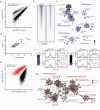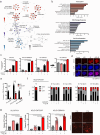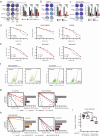Rapid P-TEFb-dependent transcriptional reorganization underpins the glioma adaptive response to radiotherapy
- PMID: 38816355
- PMCID: PMC11139976
- DOI: 10.1038/s41467-024-48214-3
Rapid P-TEFb-dependent transcriptional reorganization underpins the glioma adaptive response to radiotherapy
Abstract
Dynamic regulation of gene expression is fundamental for cellular adaptation to exogenous stressors. P-TEFb-mediated pause-release of RNA polymerase II (Pol II) is a conserved regulatory mechanism for synchronous transcriptional induction in response to heat shock, but this pro-survival role has not been examined in the applied context of cancer therapy. Using model systems of pediatric high-grade glioma, we show that rapid genome-wide reorganization of active chromatin facilitates P-TEFb-mediated nascent transcriptional induction within hours of exposure to therapeutic ionizing radiation. Concurrent inhibition of P-TEFb disrupts this chromatin reorganization and blunts transcriptional induction, abrogating key adaptive programs such as DNA damage repair and cell cycle regulation. This combination demonstrates a potent, synergistic therapeutic potential agnostic of glioma subtype, leading to a marked induction of tumor cell apoptosis and prolongation of xenograft survival. These studies reveal a central role for P-TEFb underpinning the early adaptive response to radiotherapy, opening avenues for combinatorial treatment in these lethal malignancies.
© 2024. The Author(s).
Conflict of interest statement
S.D.K received clinical trial funding from Genentech, AstraZenca, and Ionis unrelated to this work. She also receives preclinical funding from Roche, unrelated to this work. The remaining Authors declare no competing interests.
Figures








Update of
-
Rapid PTEFb-dependent transcriptional reorganization underpins the glioma adaptive response to radiotherapy.bioRxiv [Preprint]. 2023 Jan 25:2023.01.24.525424. doi: 10.1101/2023.01.24.525424. bioRxiv. 2023. Update in: Nat Commun. 2024 May 30;15(1):4616. doi: 10.1038/s41467-024-48214-3. PMID: 36747867 Free PMC article. Updated. Preprint.
References
MeSH terms
Substances
Grants and funding
- K08 NS121592/NS/NINDS NIH HHS/United States
- 1K08NS121592-01A1/U.S. Department of Health & Human Services | NIH | National Institute of Neurological Disorders and Stroke (NINDS)
- P50 CA261605/CA/NCI NIH HHS/United States
- R01 DE028529/DE/NIDCR NIH HHS/United States
- 1R01DE028282-01/U.S. Department of Health & Human Services | NIH | National Institute of Dental and Craniofacial Research (NIDCR)
- P30 CA046934/CA/NCI NIH HHS/United States
- R01 DE028282/DE/NIDCR NIH HHS/United States
- S10 OD023485/OD/NIH HHS/United States
- K12 HD068372/HD/NICHD NIH HHS/United States
- 5K12HD068372-09/U.S. Department of Health & Human Services | NIH | Eunice Kennedy Shriver National Institute of Child Health and Human Development (NICHD)
LinkOut - more resources
Full Text Sources
Molecular Biology Databases
Research Materials

